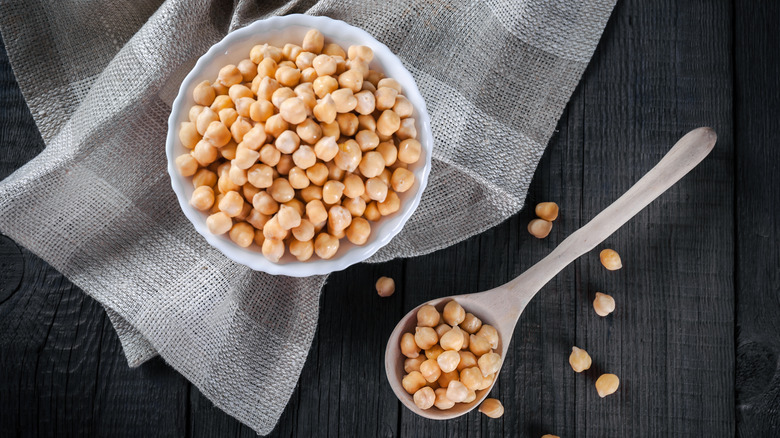Can You Use Chickpeas As A Replacement For Hominy?
First things first: Hominy is an incredible, versatile ingredient with a long and fascinating history. It definitely deserves a place in every kitchen, whether it's used for a silky-smooth coconut curried hominy soup, or some deliciously dippable hominy fritters with bacon thyme sauce. But what if you find yourself running short on hominy? Or craving something just a little bit different? Could you opt for using chickpeas as a replacement? Absolutely!
Swapping hominy and chickpeas works really well, and one of the things that you'll absolutely love is that it's one of the easiest swaps you'll make in the kitchen. There's no math or conversions necessary, as you can simply use an amount of chickpeas equal to the amount of hominy that your recipe calls for. That works with both dry and canned hominy: Replace dry hominy with dry chickpeas and canned hominy with canned chickpeas, and that's it.
For some, this simple swap can open up a whole new group of recipes. Hominy is a staple food that dates back to somewhere between 3000 and 2000 B.C., and even though it's still a crucial foodstuff today it might be hard to find in some areas. Fortunately, this easy chickpea swap will allow you to try some amazing hominy-based recipes — no hominy required.
Here's why chickpeas are such a great hominy substitute
It's no secret that some ingredient swaps work better than others. Some might leave the final product tasting a little off, and it might be clear that there were some cooking shenanigans going on in the kitchen. In spite of the fact that hominy is corn and chickpeas are legumes, there's a few reasons the swap works really well.
For starters, chickpeas and hominy have a very similar size, shape, and texture: That means that when you swap in the chickpeas, you're still getting the same heartiness and mouthfeel that you would with hominy. The texture of hominy actually comes thanks to something called nixtamalization, which is the process that's been used for generations to turn corn into something more palatable. Corn kernels are processed by being soaked in an alkaline solution, which makes them easily digestible, and essentially unlocks vital nutrients like protein and calcium. It also makes the kernels softer and puffier, transforming them into something not unlike chickpeas.
Nixtamalization also makes corn taste better, and the end result is hominy, which is often described similarly to chickpeas. They both bring a subtle, earthy, nutty flavor that works really well in countless dishes, particularly in soups or hearty meals like a pork and chorizo hominy stew with poached eggs.
Replacing hominy with chickpeas can add major nutritional benefits
Hominy has been a huge deal, historically speaking. The ancient process of nixtamalization made corn not only easier to grind and work with but much more nutritious as well. However, put hominy and chickpeas side-by-side, and it turns out that substituting chickpeas is an easy way to add even more nutritional benefits to your favorite hominy-based meal. Chickpeas are higher in calcium, iron, magnesium, phosphorus, and zinc, as well as vitamins like K and A. They're also much lower in sodium, which can be hugely beneficial for anyone who's watching their sodium intake.
Just as hominy and corn formed a major part of diets across the Americas for thousands of years, chickpeas have been a staple food in the Middle East for just as long. They've also been the subject of scientific research that's found they have all kinds of benefits beyond their nutritional numbers. The high-fiber and high-protein content of chickpeas have been found to help with the regulation of blood sugar, the management of healthy gut bacteria, the reduced risk of conditions like irritable bowel syndrome, type 2 diabetes, heart disease, and even certain kinds of cancer. Chickpeas are, in a nutshell, pretty amazing.


